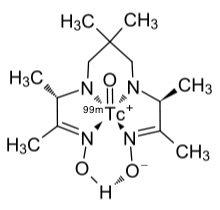D.8 Nuclear medicine
Written specifically for students to provide help and support for the IB Diploma chemistry programme this page provides full coverage of the syllabus content of Option D - sub topic D.8. It encourages you to think critically and provides many questions with full worked answers so that you can monitor and improve your knowledge and understanding.

 Learning outcomes
Learning outcomes
 After studying this topic you should be able to:
After studying this topic you should be able to:
Understand
- Many different types of emissions (e.g. alpha, beta, gamma, proton, neutron and positron) are used for medical investigations and treatment.
- MRI (magnetic resonance imaging) is an application of NMR technology.
- Radiotherapy can be used internally and/or externally.
- TAT (targeted alpha therapy) and BNCT (boron neutron capture therapy) are two different methods used in the treatment of cancer.
Apply your knowledge to:
- Discuss the common side effects of radiotherapy.
- Explain (based on its half-life, emission type and chemistry) why technetium-99m is the most common radioisotope used in nuclear medicine.
- Explain (based on the type of radiation emitted) why lutetium-177 and yttrium-90 are common isotopes used for radiotherapy .
- Balance nuclear equations that involve alpha and beta particles.
- Use the nuclear half-life equation to calculate both the percentage and the amount of radioactive material decayed and remaining after a certain period of time .
- Explain TAT and how it can be used to treat diseases that have spread throughout the body.
Relationships & vocabulary
Nature of science
The benefits of the technique(s) being considered need to be balanced against the risks associated with the exposure to radiation.International-mindedness
Culture, cost, availability and beliefs are some of the factors that can influence the use of nuclear technology in medicine and explain why its use is not consistent throughout the world.Vocabulary
| positron | radiotherapy | MRI (magnetic resonance imaging) | TAT (targeted alpha therapy) |
| half-life | radioisotope | BNCT (boron neutron capture therapy) |
Learning slides
You can use this slide gallery for learning or for reviewing concepts and information. It covers all the key points in the syllabus for this sub-topic.
Something to think about
Technetium-99m
Although much of this sub-topic deals with cancer treatment, technetium-99m, the most widely used radioisotope in medicine, is only used in diagnostic radiotherapy. It is ideal for this purpose as it is a gamma radiation emitter with a half-life of 6.0 hours. This means that within 24 hours 94% of it will have decayed to technetium-99. It also has a short biological half-life of one day, which means that it is readily excreted in urine from the body. Several other factors also make it an ideal diagnostic tool. The radiation emitted can easily be followed by conventional X-ray equipment and the breakdown product, technetium-99, has a much longer half-life of 2.11 x 105 years. Technetium-99 is a beta emitter, which breaks down to form stable ruthenium-99, this also contributes to keeping the patient’s total exposure to radiation low – although it is not totally risk free.
Technetium-99m is an example of a nuclear isomer. Technically a nuclear isomer is caused by the excitation of one or more of the nucleons (protons or neutrons) of an atomic nucleus to give a metastable state. It is metastable compared to the normal excited nuclear state as it has a longer half-life as it reverts back to the ground state. Even so the half-life of a nuclear isomer is normally very short (greater than 1.0 x 10-9 s) but some metastable isomers, including technetium-99m have longer half-lives measurable in minutes or hours.
Although technetium-99m’s half-life of 6 hours makes it ideal for diagnostic treatment it does pose a problem of storage, as the hospital needs a fresh supply every day that it is going to be used. In fact, hospitals are supplied with its parent nucleus, molybdenum-99, and they use technetium-99m generators to prepare the metastable isotope through the beta-decay of molybdenum-99.
The isotope is chemically extracted using column chromatography usually as the water-soluble sodium salt of the technetate(VII) ion, TcO4−. It is then normally reduced to the +4 or +3 oxidation state and converted in a complex ion using a ligand, such as exametazine, for diagnostic use.

Tc-99m exametazine complex
Test your understanding of this topic
(Note that your teacher may have restricted your access to some or all of these questions and worked answers if they are going to use them as a class test or set them as an assignment.)
For ten 'quiz' questions (for quick testing of knowledge and understanding with the answers explained) see MC test: Nuclear medicine
For short-answer questions see Nuclear medicine questions together with the worked answers on a separate page Nuclear medicine answers.
More resources
1. You already know about 1H NMR from Topics 11 and 21. This video by, Howard R. Hart Jr., one of the pioneers of MRI, explains how an MRI scan works.
2. A concise animated video by Richard Thornley on TAT, targeted alpha therapy.
3. A really neat video, also by Richard Thornley, which clearly explains BNCT, boron neutron capture therapy.

 IB Docs (2) Team
IB Docs (2) Team 




















